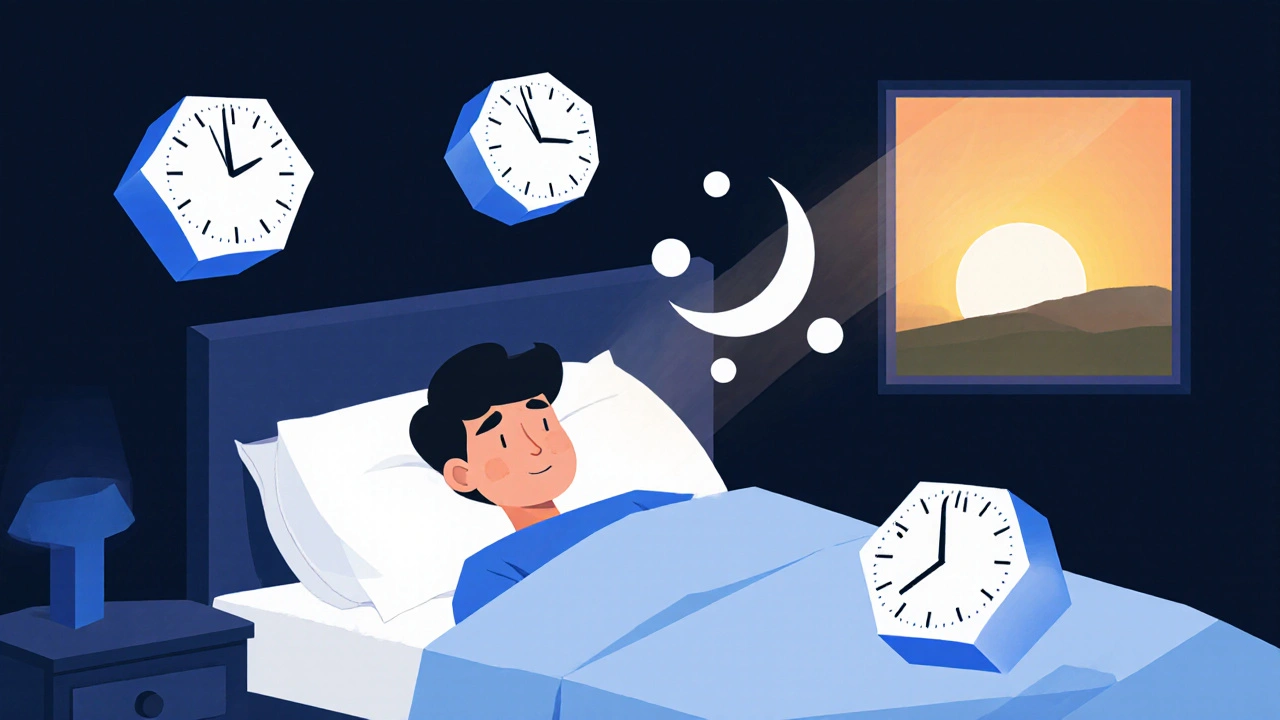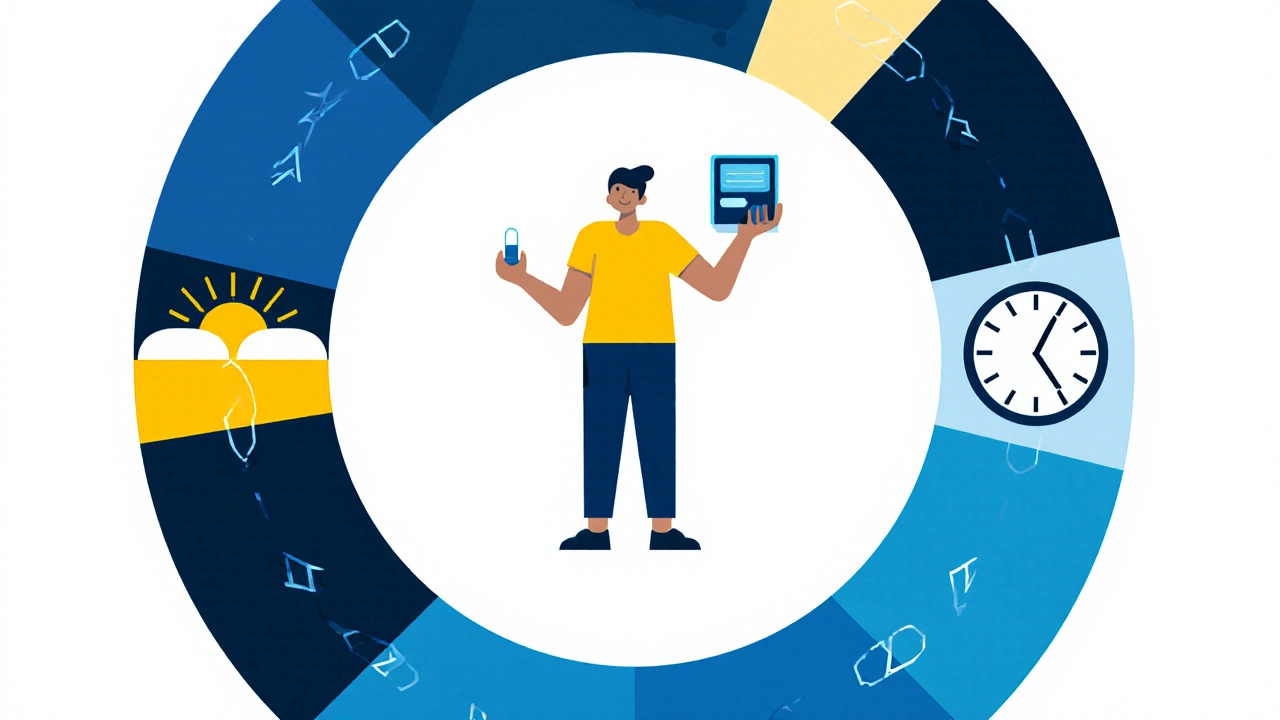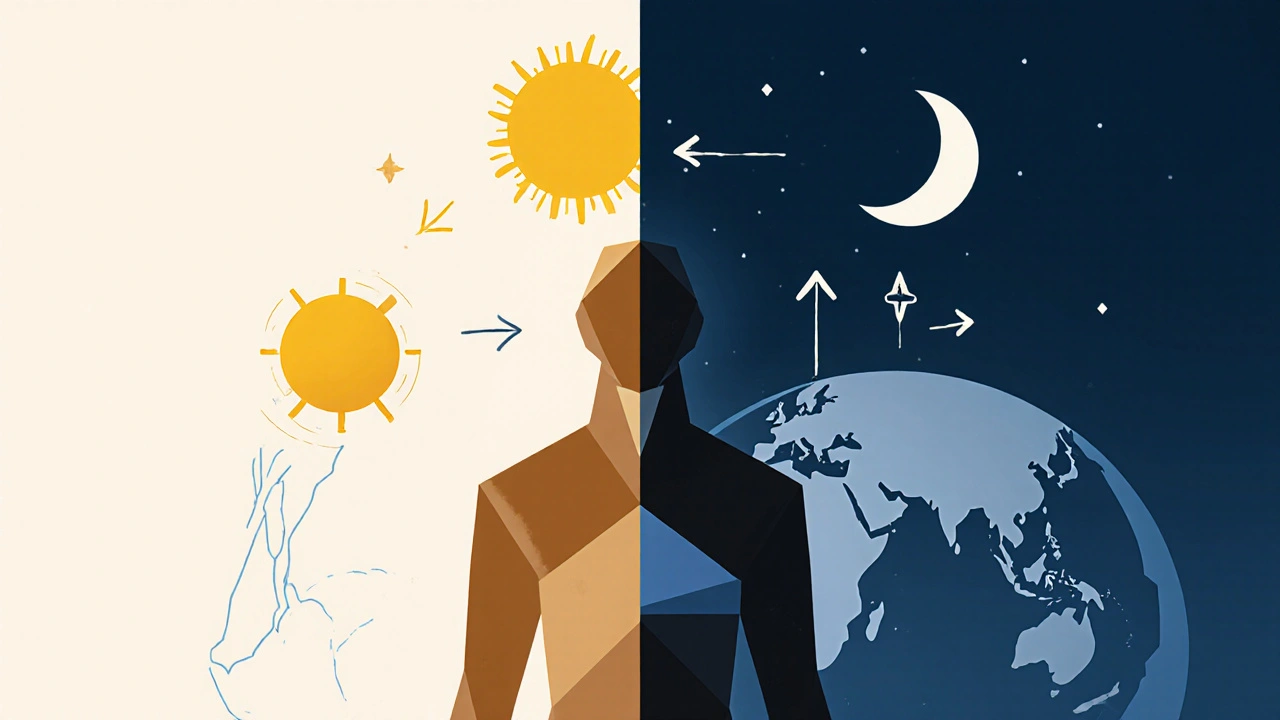Most people think sleep problems are just about stress or too much caffeine. But what if your body’s clock is simply out of sync with the world? That’s what happens in circadian rhythm disorders - your internal timing doesn’t match the time outside. Two of the most common types are jet lag and delayed sleep phase disorder (DSPD). They feel different, but they’re both about your body refusing to play by the rules of the clock.
What Is a Circadian Rhythm?
Your body runs on a 24-hour internal clock. It’s not just about sleep - it controls when you feel hungry, when your body temperature drops, when cortisol spikes, and when melatonin kicks in. This rhythm is controlled by a tiny cluster of cells in your brain called the suprachiasmatic nucleus. It’s your master clock. And it listens to light. Bright light in the morning tells your body it’s time to wake up. Darkness at night tells it to wind down. When this clock gets thrown off, you don’t just feel tired. You get foggy, irritable, nauseous, and your performance tanks. Studies show cognitive performance can drop by 20-30% during jet lag. That’s like having a blood alcohol level of 0.05% - legally impaired in many countries.Jet Lag: When Your Body Gets Left Behind
Jet lag isn’t just being tired after a long flight. It’s your internal clock still stuck in New York while your body is physically in Tokyo. The problem isn’t the flight - it’s the time zones. Crossing two or more time zones triggers it. The more zones you cross, the worse it gets. Here’s the twist: flying east is harder than flying west. Why? Because your natural circadian period is about 24.2 hours. That means your body prefers to stay up later than to wake up earlier. Going east forces you to go to bed earlier - which your body resists. Going west lets you stay up later - which your body already wants to do. After crossing five time zones eastward, it can take 5-7 days to fully adjust. Symptoms? Insomnia at night, sleepiness during the day, trouble concentrating, stomach upset, even mood swings. Business travelers report 68% less productivity for three or more days after long-haul flights. That’s not laziness - it’s biology.Delayed Sleep Phase Disorder: The Night Owl Trap
Unlike jet lag, which is temporary, delayed sleep phase disorder is chronic. People with DSPD don’t choose to stay up late. Their body won’t let them fall asleep any earlier - even if they try. Sleep onset typically happens between 3 AM and 6 AM. Wake-up time? 10 AM to 1 PM. But if they’re allowed to follow that schedule, they sleep just fine. No insomnia. No poor sleep quality. Just a clock that runs on a different time zone - permanently. It’s common in teens and young adults. Studies show 7-16% of adolescents have it. One 22-year-old student on Reddit said she failed every 8 AM class, even with accommodations. Another 28-year-old software developer said his brain works best from 2 AM to 6 AM - but he’s forced to work 9 to 5. He’s exhausted all day. That’s not laziness. That’s DSPD. The science backs it up. In DSPD patients, melatonin - the sleep hormone - starts rising about two hours later than in people with normal rhythms. That’s measured as dim light melatonin onset (DLMO). If your DLMO is at 2 AM, you’re not going to feel sleepy at 10 PM. No matter how hard you try.Jet Lag vs. DSPD: Key Differences
| Feature | Jet Lag | Delayed Sleep Phase Disorder (DSPD) |
|---|---|---|
| Duration | Days to weeks (resolves on its own) | Months to years (chronic) |
| Trigger | Travel across time zones | Genetic and environmental factors |
| Sleep quality | Disrupted during adjustment | Normal when on own schedule |
| Typical sleep onset | Varies by destination | 3 AM - 6 AM |
| Diagnosis | Clinical based on travel history | Requires DLMO testing and 3+ month history |
| Primary treatment | Light exposure timing | Light therapy + melatonin + schedule consistency |

How to Fix Jet Lag - Fast
You can’t avoid flying, but you can reduce the damage. The key is light. Light resets your clock. Darkness tells your body to sleep. Timing matters. Traveling east? You need to advance your clock. Get bright light in the morning at your destination. Avoid bright light in the evening. Start adjusting 3-5 days before departure. Shift your bedtime 1 hour earlier each night. Use a 10,000 lux light box for 30 minutes after waking. If you can’t get natural sunlight, use a lamp. Even 15 minutes of bright light in the morning helps. Traveling west? You need to delay your clock. Stay in bright light in the evening. Avoid morning light. Sleep in. Let yourself wake up later. If you land in the afternoon, stay awake until local bedtime. Even if you’re tired. Don’t nap. A 2023 study in npj Digital Medicine found that an app called Timeshifter - which gives personalized light and sleep advice based on your flight - cut jet lag recovery time by 63% compared to generic advice.How to Treat Delayed Sleep Phase Disorder
DSPD won’t fix itself. You need a plan - and consistency. 1. Morning bright light therapy. Get 30-60 minutes of bright light (10,000 lux) within one hour of your natural wake time. Even if that’s 11 AM. Use a light box. Sit near a window with no sunglasses. Don’t stare at it - just have it in your peripheral vision while you eat breakfast or read. 2. Evening melatonin. Take 0.5 mg of melatonin 5-7 hours before your desired bedtime. Not 3 mg. Not 5 mg. 0.5 mg. Most people overdose. Higher doses don’t work better - they just make you groggy. A 2022 review showed combining melatonin with light therapy gives a 2.1-hour phase advance. Light alone? Only 1.3 hours. 3. Sleep schedule consistency. This is the hardest part. No sleeping in on weekends. Even if you went to bed at 4 AM on Friday, you still have to wake up at 11 AM on Saturday. Then back to 11 AM on Sunday. Then 11 AM on Monday. Your body needs routine. Weekend binges undo weeks of progress. A 2020 study found adherence to this plan improved from 58% in week one to 89% by week six. It takes time. But 73% of DSPD patients who stuck with chronotherapy reported major improvement.Why This Matters Beyond Sleep
This isn’t just about feeling tired. Circadian disruption increases your risk of serious illness. A 2023 study from the UK Biobank found people with untreated circadian disorders had a 29% higher risk of type 2 diabetes and a 23% higher risk of heart disease. Shift workers, who often have chronic misalignment, average 4 hours less sleep per week than day workers. That’s not sustainable. Even your metabolism runs on your clock. Eating late at night when your body thinks it’s nighttime? That’s when insulin sensitivity drops. That’s how you get fat. That’s how you get prediabetes.
What Doesn’t Work
Sleeping pills? They make you drowsy, but they don’t reset your clock. You’ll still wake up at 11 AM feeling like you never slept. Melatonin taken at the wrong time? It can make things worse. Taking it at 10 PM when your body isn’t ready? You’ll just feel groggy the next day. Modafinil? Some people with DSPD use it to stay awake for work. But 22% of users in one study ended up with worse insomnia. It’s a band-aid. Not a cure.Getting Help
Most doctors don’t know much about circadian disorders. Only 4% of people with symptoms get diagnosed. But it’s getting better. The International Classification of Sleep Disorders (ICSD-4), released in 2023, now requires objective melatonin testing for DSPD diagnosis. That’s progress. If you think you have DSPD, ask for a dim light melatonin onset (DLMO) test. It’s not routine - but it’s the gold standard. Some sleep clinics offer it. Others can refer you to a specialist. For jet lag, most people don’t need a doctor. But if you’re flying often - weekly or monthly - consider seeing a sleep specialist. There are apps, light therapy devices, and personalized schedules that can help.What’s Next
Circadian medicine is becoming part of mainstream health. By 2027, 45% of family doctors in Europe are expected to screen for circadian misalignment. Wearable devices are getting better at tracking your body’s rhythms - not just steps and heart rate, but core body temperature and melatonin patterns. The future isn’t just pills. It’s personalized timing. When to eat. When to exercise. When to be exposed to light. When to sleep. Your body isn’t broken. It’s just out of sync. And now we know how to fix it.Can jet lag last longer than a week?
Yes, especially after crossing five or more time zones going east. Most people recover in 5-7 days, but some take up to 10 days, particularly if they’re older, have poor sleep hygiene, or don’t use light therapy. The rule of thumb is 1-1.5 days per time zone crossed. So crossing 8 time zones could mean up to 12 days to fully adjust.
Is delayed sleep phase disorder just laziness?
No. DSPD is a medically recognized circadian rhythm disorder. People with DSPD sleep normally when allowed to follow their natural schedule. The problem is their body clock is delayed by 2+ hours compared to societal norms. Brain imaging and melatonin tests confirm it’s biological, not behavioral. Many high-achieving students and professionals have DSPD - they just work at night.
Can I use melatonin to fix jet lag?
Yes - but timing matters. For eastward travel, take 0.5 mg of melatonin at bedtime in the new time zone for 3-4 days. For westward travel, it’s less effective. Melatonin helps signal sleep time, but light exposure is the main tool for resetting your clock. Don’t take more than 0.5-1 mg - higher doses cause grogginess and don’t work better.
Why is DSPD more common in teens?
During puberty, the body’s circadian clock naturally delays - this is normal. But in some teens, the delay is extreme and persistent. Genetic factors play a big role. Variants in genes like PER3, CLOCK, and CRY1 are linked to later sleep timing. Combine that with late-night screen use and early school start times, and you get a perfect storm. It’s not rebellion - it’s biology.
Can I fix DSPD without medication?
Yes - and most experts recommend it. The most effective treatment is a combination of morning bright light therapy and strict sleep schedule adherence. Melatonin (0.5 mg) can help, but it’s not required. Many people improve with just light and routine. The challenge is consistency. Missing even one day, especially on weekends, can set you back weeks.


Gerald Cheruiyot
Finally someone explains why I feel like a zombie every Monday after a weekend trip. My body still thinks it’s in Colorado while my brain is stuck in New York. No amount of coffee fixes this. Just light and patience. 🌅